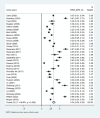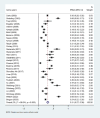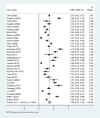Meta-analysis and systematic review of the relationship between sex and the risk or incidence of poststroke aphasia and its types
- PMID: 38438862
- PMCID: PMC10910787
- DOI: 10.1186/s12877-024-04765-0
Meta-analysis and systematic review of the relationship between sex and the risk or incidence of poststroke aphasia and its types
Abstract
Objective: To analyse and discuss the association of gender differences with the risk and incidence of poststroke aphasia (PSA) and its types, and to provide evidence-based guidance for the prevention and treatment of poststroke aphasia in clinical practice.
Data sources: Embase, PubMed, Cochrane Library and Web of Science were searched from January 1, 2002, to December 1, 2023.
Study selection: Including the total number of strokes, aphasia, the number of different sexes or the number of PSA corresponding to different sex.
Data extraction: Studies with missing data, aphasia caused by nonstroke and noncompliance with the requirements of literature types were excluded.
Data synthesis: 36 papers were included, from 19 countries. The analysis of 168,259 patients with stroke and 31,058 patients with PSA showed that the risk of PSA was 1.23 times higher in female than in male (OR = 1.23, 95% CI = 1.19-1.29, P < 0.001), with a prevalence of PSA of 31% in men and 36% in women, and an overall prevalence of 34% (P < 0.001). Analysis of the risk of the different types of aphasia in 1,048 patients with PSA showed a high risk in females for global, broca and Wenicke aphasia, and a high risk in males for anomic, conductive and transcortical aphasia, which was not statistically significant by meta-analysis. The incidence of global aphasia (males vs. females, 29% vs. 32%) and broca aphasia (17% vs 19%) were higher in females, and anomic aphasia (19% vs 14%) was higher in males, which was statistically significant (P < 0.05).
Conclusions: There are gender differences in the incidence and types of PSA. The risk of PSA in female is higher than that in male.
Keywords: Poststroke aphasia; Sex; aphasia type; incidence rate; stroke.
© 2024. The Author(s).
Conflict of interest statement
The authors declare no competing interests.
Figures














Similar articles
-
Head Acupuncture Plus Schuell's Language Rehabilitation for Post-Stroke Aphasia: A Systematic Review and Meta-Analysis of 32 Randomized Controlled Trials.Chin J Integr Med. 2022 Aug;28(8):743-752. doi: 10.1007/s11655-022-3722-5. Epub 2022 Jul 30. Chin J Integr Med. 2022. PMID: 35907173
-
Effects of Five-Element Music on Language Recovery in Patients with Poststroke Aphasia: A Systematic Review and Meta-Analysis.J Altern Complement Med. 2019 Oct;25(10):993-1004. doi: 10.1089/acm.2018.0479. Epub 2019 Jul 12. J Altern Complement Med. 2019. PMID: 31298550
-
Aphasia after stroke: type, severity and prognosis. The Copenhagen aphasia study.Cerebrovasc Dis. 2004;17(1):35-43. doi: 10.1159/000073896. Epub 2003 Oct 3. Cerebrovasc Dis. 2004. PMID: 14530636
-
A literature review and meta-analysis of the optimal factors study of repetitive transcranial magnetic stimulation in post-infarction aphasia.Eur J Med Res. 2024 Jan 3;29(1):18. doi: 10.1186/s40001-023-01525-5. Eur J Med Res. 2024. PMID: 38173039 Free PMC article. Review.
-
Aphasia type and aging in Hindi-speaking stroke patients.Brain Lang. 2002 Nov;83(2):353-61. doi: 10.1016/s0093-934x(02)00039-1. Brain Lang. 2002. PMID: 12387802
Cited by
-
Precision-Optimised Post-Stroke Prognoses.Ann Clin Transl Neurol. 2025 Aug;12(8):1619-1627. doi: 10.1002/acn3.70077. Epub 2025 Jun 12. Ann Clin Transl Neurol. 2025. PMID: 40506865 Free PMC article.
References
Publication types
MeSH terms
Grants and funding
LinkOut - more resources
Full Text Sources
Medical
Research Materials
Miscellaneous

